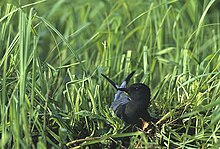White-winged tern
| White-winged tern | ||||||||||
|---|---|---|---|---|---|---|---|---|---|---|

White-winged terns in the Narew Valley in Poland |
||||||||||
| Systematics | ||||||||||
|
||||||||||
| Scientific name | ||||||||||
| Chlidonias leucopterus | ||||||||||
| ( Temminck , 1815) |
The white-winged tern ( Chlidonias leucopterus ) is a species of bird from the family of the tern (Sternidae) native to southeast Europe .
Appearance
Brood plumage
The male of the white-winged tern has a black head, neck and front back. A dark gray show shoulder plumage, back and underside to the abdomen. The rump , upper and lower tail- coverts and the control feathers are white. The arm wings and the large upper wing coverts are slate gray, the middle ceilings lighter gray and the small upper wing coverts white. The bow feathers and the rearmost row of the under wing coverts are light gray, all other under wing coverts like the axillary feathers are black.
The female has a black head and body plumage in the breeding plumage, which is somewhat more dull than that of the male, and a white or light gray rump and tail. The lower wings are black and, in contrast, the upper wings are white.
Resting dress
Both sexes look the same when they are resting. The forehead and front of the head are white, the rear parting and the nape are gray-black. The collar is white. The front back is dark gray, the rest of the top is light gray. The arm wings are light gray, with a narrow white border on the outside and getting darker and darker towards the inside.
Youth dress
The plumage is relatively uniformly dark brown, with the gray of the feather bases partially shining through. The shoulder springs and inner arm wings are light gray with crescent-shaped rust-brown subterminal spots . The rump is clearly set off white to gray, the upper tail-coverts light gray.
General
The wingspan is between 595 and 656 mm. The beak is slightly shorter and more compact than that of the similar black tern . The head drawing shows a blackish, narrow, white-dashed head plate with a slightly narrower neck protection that extends forward over the eye , which is separated from the gray coat plumage by a narrow, white collar. A very clear white oval to rectangular ear field sets the head away from the black ear cover and the temple covers. Occasionally the tern has a patch on the chest, but this is only weakly pronounced and less clear than the black tern.
The moult starts from October and the back and breast feathers then have a grayish color.
voice
The voice is similar to that of the white-bearded tern and the call is dry and harsh. It is also compared to the reputation of the partridge .
behavior
When at rest, the white-winged tern retracts its head, making the top and back almost form a straight line. When she sleeps she puts her beak into her shoulder feathers. The flight of the terns is fluttering and they occasionally land on the water.
food
The main food is aquatic insects such as dragonflies, beetles, larvae and mosquitoes, but also grasshoppers and crickets. Small fish are also less common. They look for food in the shallow bank water or they fly in an arc flight 30 to 50 centimeters above the water.
Breeding biology
The white-winged tern needs shallow waters to breed. The breeding area extends from the Far East to Central Europe. Thereby breeding colonies of 100 to 150 specimens are formed. The tern becomes sexually mature at the age of two and then leads a monogamous seasonal marriage. The nests are often anchored floating between plant stalks or on bumps just above the water. The nest, made up of mostly green stalks and leaves, typically has a diameter of 11 to 16 centimeters and is three to five centimeters high. The eggs measure an average of 34 × 25 millimeters. There are typically three eggs per nest, but clutches of four to five, less often six eggs are also possible. The breeding season begins around June, in Hungary as early as mid-May. Breeding lasts 18 to 20 days, with broken clutches being generally replaced by the birds at the beginning of the breeding season. The chicks leave the nest about two to three days after hatching. They can fly 20 to 25 days after hatching and are then fed by their parents for up to ten days.
hikes
The bird overwinters in the temperate southern zones and the tropics. The population of Eastern Siberia and Manchuria moves via the Philippines and Indochina to the south of Thailand and Burma as well as to the east coast of India . Sometimes they even migrate to Australia and New Zealand . The European and Turkestan populations migrate via Arabia and the Sahara into the Sahel zone to southern Africa. During their wanderings, trains of an estimated 10,000 are sometimes formed.
Persistence and Threat
By far the largest breeding colony in Germany is located in the Lower Oder Valley National Park . In 2006, 50 pairs brooded there and 45 young could be counted. The birds had already tried breeding in 1996, but they were unsuccessful. On the western edge of the range, the number of birds increases.
literature
- Delina, Hakan, Svensson, Lars, Der Kosmos-Vogelatlas , translated by Peter H. Barthel, ISBN 3-7632-4277-5
- Urs N. Glutz von Blotzheim & Kurt M. Bauer (eds.): Handbook of the birds of Central Europe , AULA-Verlag, Wiesbaden 1994; Volume 8, pages 993-1013 ISBN 3-89104-562-X
Web links
- Image of the white-winged tern. In: BirdNet Galery. Retrieved March 10, 2010 .
- Chlidonias leucopterus in the endangered Red List species the IUCN 2009. Posted by: BirdLife International, 2009. Accessed on March 10 of 2010.
- Videos, photos and sound recordings of Chlidonias leucopterus in the Internet Bird Collection
- White-winged tern feathers
Footnotes
- ↑ Märkische Oderzeitung, July 6, 2006, p. 14

